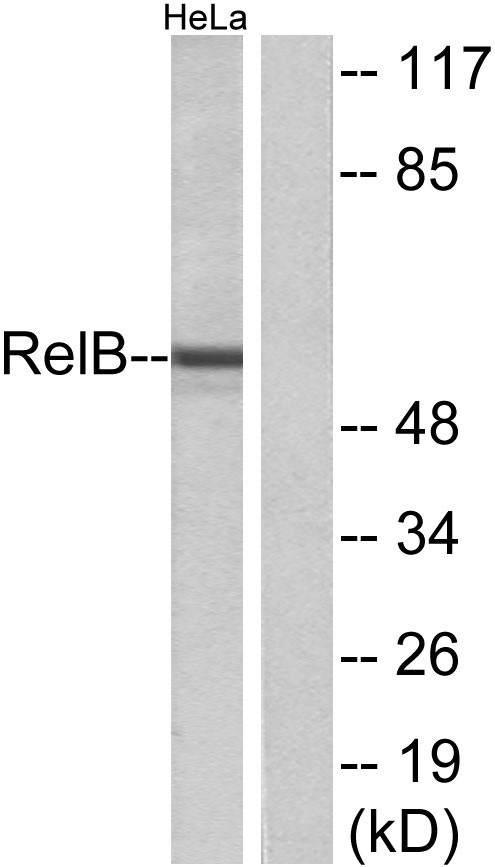RelB (phospho Ser552) Polyclonal Antibody
- Catalog No.:YP0844
- Applications:WB;IHC;IF;ELISA
- Reactivity:Human;Mouse
- Target:
- RelB
- Fields:
- >>MAPK signaling pathway;>>NF-kappa B signaling pathway;>>Osteoclast differentiation;>>C-type lectin receptor signaling pathway;>>Human T-cell leukemia virus 1 infection;>>Epstein-Barr virus infection
- Gene Name:
- RELB
- Protein Name:
- Transcription factor RelB
- Human Gene Id:
- 5971
- Human Swiss Prot No:
- Q01201
- Mouse Gene Id:
- 19698
- Mouse Swiss Prot No:
- Q04863
- Immunogen:
- The antiserum was produced against synthesized peptide derived from human RelB around the phosphorylation site of Ser552. AA range:530-579
- Specificity:
- Phospho-RelB (S552) Polyclonal Antibody detects endogenous levels of RelB protein only when phosphorylated at S552.
- Formulation:
- Liquid in PBS containing 50% glycerol, 0.5% BSA and 0.02% sodium azide.
- Source:
- Polyclonal, Rabbit,IgG
- Dilution:
- WB 1:500 - 1:2000. IHC 1:100 - 1:300. ELISA: 1:20000.. IF 1:50-200
- Purification:
- The antibody was affinity-purified from rabbit antiserum by affinity-chromatography using epitope-specific immunogen.
- Concentration:
- 1 mg/ml
- Storage Stability:
- -15°C to -25°C/1 year(Do not lower than -25°C)
- Other Name:
- RELB;Transcription factor RelB;I-Rel
- Observed Band(KD):
- 62kD
- Background:
- caution:Was originally (PubMed:1577270) thought to inhibit the transcriptional activity of nuclear factor NF-kappa-B.,domain:Both N- and C-terminal domains are required for transcriptional activation.,function:NF-kappa-B is a pleiotropic transcription factor which is present in almost all cell types and is involved in many biological processed such as inflammation, immunity, differentiation, cell growth, tumorigenesis and apoptosis. NF-kappa-B is a homo- or heterodimeric complex formed by the Rel-like domain-containing proteins RELA/p65, RELB, NFKB1/p105, NFKB1/p50, REL and NFKB2/p52. The dimers bind at kappa-B sites in the DNA of their target genes and the individual dimers have distinct preferences for different kappa-B sites that they can bind with distinguishable affinity and specificity. Different dimer combinations act as transcriptional activators or repressors, respectively. NF-kappa-B is controlled by various mechanisms of post-translational modification and subcellular compartmentalization as well as by interactions with other cofactors or corepressors. NF-kappa-B complexes are held in the cytoplasm in an inactive state complexed with members of the NF-kappa-B inhibitor (I-kappa-B) family. In a conventional activation pathway, I-kappa-B is phosphorylated by I-kappa-B kinases (IKKs) in response to different activators, subsequently degraded thus liberating the active NF-kappa-B complex which translocates to the nucleus. NF-kappa-B heterodimeric RelB-p50 and RelB-p52 complexes are transcriptional activators. RELB neither associates with DNA nor with RELA/p65 or REL. Stimulates promoter activity in the presence of NFKB2/p49.,induction:By mitogens.,PTM:Phosphorylation at 'Thr-103' and 'Ser-573' is followed by proteasomal degradation.,similarity:Contains 1 RHD (Rel-like) domain.,subunit:Component of the NF-kappa-B RelB-p50 complex. Component of the NF-kappa-B RelB-p52 complex. Self-associates; the interaction seems to be transient and may prevent degradation allowing for heterodimer formation with p50 or p52. Interacts with NFKB1/p50, NFKB2/p52 and NFKB2/p100. Interacts with NFKBID.,
- Function:
- caution:Was originally (PubMed:1577270) thought to inhibit the transcriptional activity of nuclear factor NF-kappa-B.,domain:Both N- and C-terminal domains are required for transcriptional activation.,function:NF-kappa-B is a pleiotropic transcription factor which is present in almost all cell types and is involved in many biological processed such as inflammation, immunity, differentiation, cell growth, tumorigenesis and apoptosis. NF-kappa-B is a homo- or heterodimeric complex formed by the Rel-like domain-containing proteins RELA/p65, RELB, NFKB1/p105, NFKB1/p50, REL and NFKB2/p52. The dimers bind at kappa-B sites in the DNA of their target genes and the individual dimers have distinct preferences for different kappa-B sites that they can bind with distinguishable affinity and specificity. Different dimer combinations act as transcriptional activators or repressors, respectively. NF-k
- Subcellular Location:
- Nucleus . Cytoplasm, cytoskeleton, microtubule organizing center, centrosome . Colocalizes with NEK6 in the centrosome.
- Expression:
- Blood,T-cell,
- June 19-2018
- WESTERN IMMUNOBLOTTING PROTOCOL
- June 19-2018
- IMMUNOHISTOCHEMISTRY-PARAFFIN PROTOCOL
- June 19-2018
- IMMUNOFLUORESCENCE PROTOCOL
- September 08-2020
- FLOW-CYTOMEYRT-PROTOCOL
- May 20-2022
- Cell-Based ELISA│解您多样本WB检测之困扰
- July 13-2018
- CELL-BASED-ELISA-PROTOCOL-FOR-ACETYL-PROTEIN
- July 13-2018
- CELL-BASED-ELISA-PROTOCOL-FOR-PHOSPHO-PROTEIN
- July 13-2018
- Antibody-FAQs
- Products Images

- Enzyme-Linked Immunosorbent Assay (Phospho-ELISA) for Immunogen Phosphopeptide (Phospho-left) and Non-Phosphopeptide (Phospho-right), using RelB (Phospho-Ser552) Antibody

- Immunohistochemistry analysis of paraffin-embedded human breast carcinoma, using RelB (Phospho-Ser552) Antibody. The picture on the right is blocked with the phospho peptide.

- Western blot analysis of lysates from LOVO cells and RAW264.7 cells, using RelB (Phospho-Ser552) Antibody. The lane on the right is blocked with the phospho peptide.

